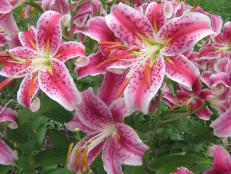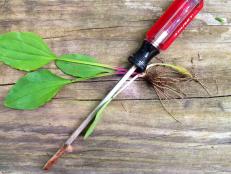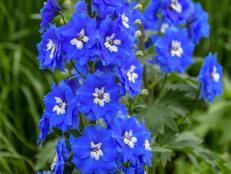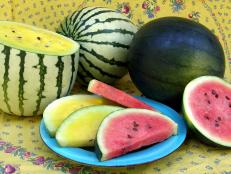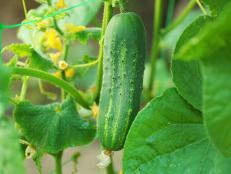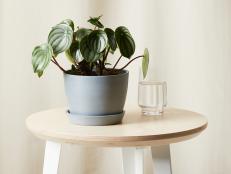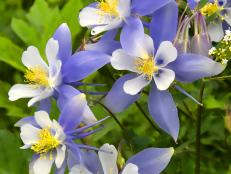Planting and Growing Daffodils
Learn how to grow and care for daffodils, plus get expert advice on which variety of daffodil flowers to choose for your growing conditions.

National Garden Bureau/Longfield Gardens

Could there be happier harbingers of spring than daffodils, unfurling their golden trumpets to beckon the sun? It is a hopeful moment on the pale edge of winter when daffodils dot sleepy street corners with their bright-eyed faces, reminding us that we are surrounded by invisible awakenings.
Blooming from bulbs in various sunkissed shades, daffodils — also known as narcissus — are an effortless addition to most any garden. Dive in and discover how to select, plant, harvest and care for daffodils.
Daffodils 101
Daffodils (known botanically as Narcissus) are easy-to-grow, springtime-blooming perennial bulbs that are hardy in zones 3-8. In addition to blooming annually, they also naturalize, meaning they multiply and spread. Daffodil cultivars are organized into 13 divisions, based on breeding and how the flowers’ components (coronas, trumpets, petals, etc.) are structured.
18 Favorite Bulb Flowers for Year-Round Color 19 Photos
Daffodils are among our favorite bulbs you can count on to to create a year-long parade of color.
While it is possible to grow some type of narcissus anywhere in the United States, not every division will thrive in every zone. Learn the divisions below and choose a daffodil that suits your space. Across these categories there are more than 25,000 cultivars, offering a deep well of options. With staggering variety and ease of cultivation, narcissi offer inspiration to gardeners, farmers, landscapers and florists alike.
Daffodil Types
Daffodils are organized into 13 official divisions by form, breeding and origin. Each division contains many unique varieties and all follow similar growing requirements (with a few conditions). Knowing all the divisions by heart is less important for gardeners than knowing the ones that will best suit your style and space. Let these guidelines inform your selection:
- Jonquilla and tazetta daffodils are ideal for southern gardens and for forcing indoors, with multiple miniature blooms on each stem and intoxicating fragrance. These do not require a cold period before blooming.
- The poeticus types perform best in northern zones, preferring a prolonged period of cold temperatures and a disdain for heat and drought. Featuring a tiny red-rimmed central cup, these daffodils are striking to behold and seem to gaze back.
- Most amenable to dampness are the triandrus, also known as orchid daffodils. These feature nodding blooms with dainty, reflexed petals.
- Flower farmers and florists covet the large-cupped, double, and split-cupped types. Large-cupped and split-cupped daffodils have very open, ruffled centers, while the double types feature stacked layers of petals, like a fine dessert.
- If the classic white and yellow daffodils that blankets old homesteads are what you seek, then the trumpet, small-cupped, cyclamineus, or wild types are fitting choices. Note that cyclamineus and wild types will be smaller in stature but will naturalize abundantly and offer heirloom charm. The yellow trumpets and small-cupped daffodils have been bred to bloom taller and are widely available in stores.
- Explore the bulbocodium class, also called species daffodils, for their quirky, unexpected forms. Although these daffodils are small in scale, they are fun and fascinating, reminiscent of tiny hoop skirts or pendant lamps turned towards the sun.
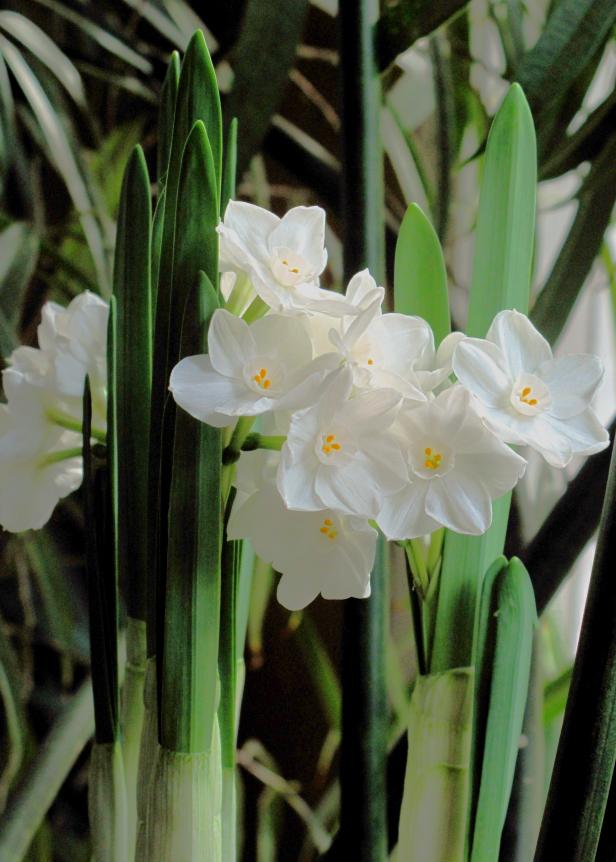
Photo by Felder Rushing
Narcissus tazetta bulbs are easy to grow indoors in pots or in water even in the winter.
To understand the botanical attributes of these divisions more deeply, explore resources from The Daffodil Society or Daffodil USA.
How to Grow Daffodils
Daffodils should be planted in fall into well-draining soil, in full sun to part shade. Narcissus are often seen planted in the understory of deciduous trees; this works because they do most of their growing during the trees’ leafless months. Sunny spots beyond the dripline of trees are generally best for daffodils.
When to Plant Daffodil Bulbs
When to plant daffodils is a common question, and the exact date depends on the weather. Daffodils need a period of cold exposure prior to emergence, so fall planting sets them up for success. In cooler climates, September is best; in warmer zones, plant daffodils in November. The soil should be 55-60 degrees at planting time.
Selecting Daffodil Bulbs
Daffodils are available from many online suppliers, as well as local garden centers. Colorful and unique cultivars are growing in popularity.
Buy Daffodil Bulbs
Shop around or check with your local daffodil association for recommendations on reputable sources. When selecting bulbs, choose those that are plump, dry and firm to the touch, with no signs of insect or disease infestation.
Preparing a Bed for Daffodils
A sunny location with well-draining soil — either on a hillside or in a raised bed — is ideal for daffodils. Neutral soil pH is a requirement of healthy root growth, so amend if your soil is acidic or alkaline.

W Atlee Burpee Company
Daffodil 'Charming Lady' is a small-cupped daffodil.
Once your site is selected, incorporate neutral amendments like well-rotted leaves, peat or sand, ensuring good drainage is achieved. Bulbs should not touch granular fertilizer, so work it into the entire planting bed thoroughly (instead of into individual planting holes) to avoid burning. Nitrogen-rich amendments like homemade compost or manure may also burn bulbs, so choosing well-aged, lightweight organic matter is a must.
You may not need a new garden bed to grow daffodils. Bulbs perform well planted in between other perennials as they work together to create a year-round display of color. Daffodils bloom while many other plants are just awakening from dormancy and neighboring plants fill out with foliage just as the daffodils die back.
Planting Daffodil Bulbs in the Garden
When planting daffodils, the depth of the bulb should be twice its diameter. For example, a 2 inch bulb should be planted with its nose pointed up, covered in 4 inches of soil. Plant bulbs 6-12 inches apart — closer for cut flowers or showy first-year displays and farther for low-maintenance naturalization. Closely planted bulbs should be dug and divided every three years. Plan to plant in clusters of 10-20 bulbs for impact.
Daffodils should be well-watered at planting time and soil should be kept moist through flowering. Once plants stop flowering, cease watering to avoid rot. Mulching newly planted beds with pine bark, straw or leaf mulch aids in soil health, weed suppression, temperature consistency and moisture retention.
Forcing Daffodil Bulbs Indoors
Before attempting to force daffodil bulbs indoors, check which kind of daffodil you are working with and the conditions it requires. While it is possible to pre-chill bulbs in the refrigerator to mimic the cold period they would experience outdoors, you may prefer to skip that step.
The tazetta (paperwhite) and jonquil divisions do not require the same cold period as others. They will emerge readily indoors as soon as they are tucked into a moist planting medium (or a bit of gravel and water) and kept in a sunny spot. If forcing in water, try adding a bit of alcohol to avoid leggy flowers.
How to Care for Daffodils
Fertilizing Daffodils
Seek a bulb-specific, organic fertilizer that is lower in nitrogen. Work granular bulb fertilizer into the soil thoroughly before planting, but never directly into the planting hole, as it could burn the bulb. To encourage eager blooms, the soil can be top-dressed after shoots emerge and again at flowering time.
Weeding
Daffodils are hardy competitors in the garden, but they require breathing room to bloom abundantly. Check daffodil beds regularly for weeds, especially when plants are just emerging and in danger of being smothered.
Daffodil Pests and Disease
While daffodils are not commonly plagued by pests and diseases, there are some potential issues to monitor. Bulb rot (a fungus) is the most common issue, resulting from hot, damp conditions and poor drainage. It is especially likely in the South. While relatively rare, nematode infestation in daffodil bulbs is possible and must be immediately addressed with help from your cooperative extension service. Bulb flies, bulb mites, slugs, snails and certain viruses may also pose problems. When purchasing bulbs, ensure there is no sign of disease or insect infestation (like softness, discoloration or holes), and look for hot-water treated bulbs.
Deadheading and (Not) Pruning
While deadheading spent daffodil blooms is optional, it can help the plant continue flowering or, if the curtain is closing on spring, to send energy into the bulb for next season’s show.
Daffodil foliage will flop over toward the end of the flowering season and it can be tempting to cut it back for a tidy appearance. However, it is important to keep these leaves attached to their bulbs. Even while limp and yellowing, daffodil foliage is photosynthesizing, building a healthy supply of food within the bulb that will feed next year’s flowers.
How to Harvest Daffodils
Daffodils as Cut Flowers
Daffodils should be harvested when the nodding buds have color but have not fully opened. Flowers cut after opening will only last a couple days. If cut at the proper stage, you can expect daffodils to last a week or more in clean water.
5 Ideas for More Sustainable Flower Arranging
Make sure your florals "do no harm" to nature by choosing more sustainable products and practices.
To harvest daffodils, cut the flower stem to the base of the plant. You will find that daffodils ooze a sticky sap from their cut ends. Daffodils should be placed quickly into a vase of clean water and allowed to discharge this toxic secretion. If combined with other flower types without this conditioning step, the daffodil sap will clog their vascular tissues and cause the entire vase to wilt more quickly. Refresh the water daily and always before combining daffodils with other stems.
Daffodil Toxicity
The slippery sap that oozes from daffodil stems is highly toxic to people and animals, in addition to neighboring cut flowers. Minimize your exposure and wash your hands after handling narcissus. Display daffodils on heightened surfaces to prevent accidental ingestion by pets or kids.
Design Tips
- In the garden, tuck pockets of daffodils in between summer and fall blooming perennials. The staggered bloom times will ensure a continuous display of color and maximize small spaces.
- After conditioning daffodil stems in their own vase, enjoy arranging them with other spring bloomers. Tulips, hyacinth, muscari, snapdragon and spirea all look lovely alongside daffodils.
- Try making bouquets with large-cupped, split-cupped and double narcissi. With their layered and ruffled trumpets and coronas, they almost look like peonies! Blooming in shades of salmon, orange, white and yellow, they beg to be the center of attention.













